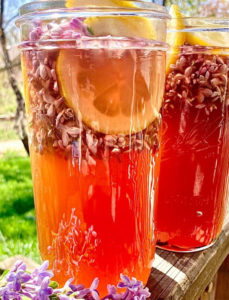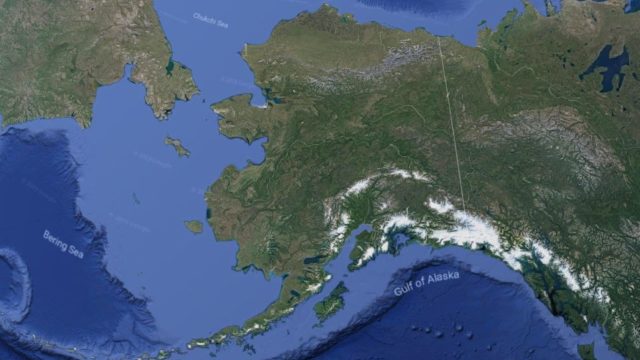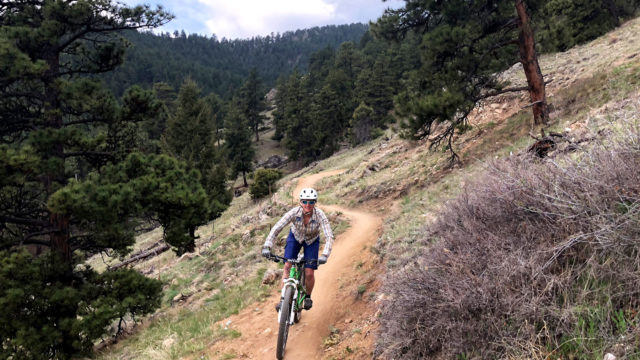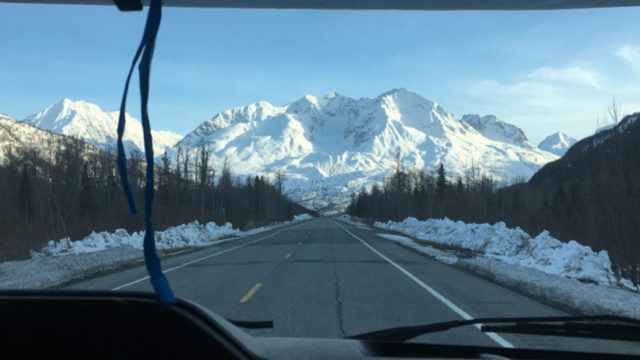Right now electric green shoots are budding out of pine trees in and around Boulder. These represent just one type of wild, uncultivated food and medicine Boulder vegetation offers up in abundance throughout the year.
Wild edibles enthusiast Kelly Zepelin recently harvested these tips from two types of Boulder spruce trees (Colorado Green and Colorado Blue) and, after wringing a slightly bitter citrusy, zesty juice from them, had them play the key lime role in a key lime pie recipe.
Spruce tips Kelly picked and turned into a key lime pie, with the tips playing the role of the key limes. (She did add some lime, too, she says). Photos: Kelly Zepelin.

That’s not the only pine item Kelly’s harvesting right now. She also now gathers pine pollen, which she bakes into a pine pollen cupcakes — the pollen stimulates as an aphrodisiac.
“I look at what is growing and what is edible,” says Kelly, who’s in the fifth year of her Ph.D. in ethnobotany under the CU’s Anthropology Department. Her dissertation centers on researching how food grown in wild spaces improves gut health by supporting a biodiverse gut biome.

Kelly recently made lilac blossom champagne by fermenting lilac blossoms in a mix of honey, champagne yeast, lemon slices, water and blueberry juice.
“Once people eat wild food, their outlook often changes, the whole world opens up in a new way … there is suddenly as whole universe of edible plants everywhere you look,” says Kelly. “And the more you build relationships to these plants, the more you want to give back.”
The Seasonal Wild Edible Dance
Like many wild edible enthusiasts, Kelly has a diverse year-round recipe stash that she cycles through as the seasons change and bounties emerge and others recede. Kelly outlined Boulder’s harvest cycle below.
Spring’s Boulder bounty includes many greens and some flowers including: burdock, dandelion, dock, garlic mustard, wild lettuce, elderflower, cattail shoots, cottonwood catkins, nettle and grass (for juicing).
Flowers take center stage in Boulder’s summer with: rose petals, linden (leaves and flowers), red clover, wild onion flowers, yucca (flower and fruits), prickly bear (pads, flowers and fruits), wild blueberries, raspberries, strawberries, bee balm, sunflowers, flax (flowers) and more.
In fall, roots, seeds and mushrooms present Boulderites with wild options. These include: morel and porcini mushrooms, rosehips, wild grass seeds, dandelion roots, chicory roots (can make a coffee out of these when dried), burdock roots.
In the winter, the wild edible low season, pine bark can be ground into a flour, pine and fir needles can garnish a tea (Kelly made chocolates with them this past winter) and hunters can turn cherry bark into a cough syrup.
Coming to the wild
Kelly jumped into wild foods after an autoimmune diagnosis. As a result, she did a gut microbiome sample and found that her gut lacked diversity and that her ratio of the two predominant types of bacteria present in our guts — bacterioties and firmicutes — stood at an unhealthy balance. Healthy guts have much more bacterioties than firmicutes.
She began incorporating wild foods into her diet. Her gut biodiversity shot up and she got better and off the immunosuppressive drugs she took for her disease.
Foods grown in local, untreated soils maintain a diverse ecosystem of microorganisms — bacteria, yeasts, fungi. These make their way into the plants they live among and in and carry to our guts when we eat them. As one of nature’s general truths, biodiversity improves the health of any ecosystem that supports it — our guts are no exception.
Not only does diversity support a more resilient system, but a wide variety of gut fauna helps support digestion and food absorption, and improves immune response.
Kelly’s dissertation touches on all these points and aims to add clarity to them.
Hunting the wild
Harvesting wild edibles requires a constant attention to detail, as the wild menu always changes, and arrives at different times each year. That drives its appeal. The practice also carries some challenges. You have to know what’s safe to eat, how to prepare it and where you can legally forage.
Private property stands as the best place to forage wild foods in the Boulder area, by far, says Kelly. Public spaces, especially those like Boulder County where the wild and urban spaces mix, prohibit harvesting in most cases. Harvesting for private use in the area National Forests even requires a permit. So keep this in mind.
Boulder has many in-between places and marginal wild zones where wild plants grow free. Foragers use these places and, even their own yards. Kelly says she has about 20 secret foraging spots in the Boulder area — many foragers keep their harvest spots quiet, as, one, they stand as a reward for attention and hunting and, two, too much use and overharvesting will destroy the plot.
When you harvest, Kelly advises, learn how to do so properly. Take just a few items from each plant.
Header image: Kelly harvesting cattails. Credit: Jordan Quaglia









